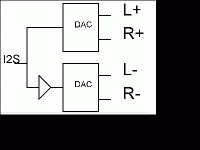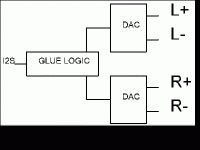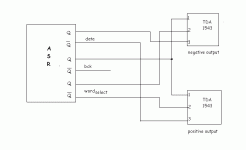I am listening to just now the dac balanced with tda 1543.I wonder how the use of this option has not been at the attention that it deserve . Well. For who it has already familiarized with asynchronous reclocker, is( thanks Elso) enough to know that I have connected 2 tda1543 to the Asr using the complementary output of the flip flop regardin the word select and the data pins for one tda. left instead the true output for every BCK pins.
Perhaps it is still soon in order to speak about like it sounds but the first impressions are good.
With some sinusoidal signals the noise increase at the increasing of the signal in the single ended mode.
This effect disappears in the balanced mode.
As a consequence the monotonic nature of the dac is increased in balanced mode .
Suggestions are the welcomes.
Perhaps it is still soon in order to speak about like it sounds but the first impressions are good.
With some sinusoidal signals the noise increase at the increasing of the signal in the single ended mode.
This effect disappears in the balanced mode.
As a consequence the monotonic nature of the dac is increased in balanced mode .
Suggestions are the welcomes.

stefanobilliani said:
With some sinusoidal signals the noise increase at the increasing of the signal in the single ended mode.
This effect disappears in the balanced mode.
As a consequence the monotonic nature of the dac is increased in balanced mode .
Hi,
I have no idea of what are you saying here, can you explain? I 'll learn something.
By the way, did you make it to Milan (top audio) last weekend?
I had to come back to the US the day it started.
Well I'll try...
A Monotonic circuit is when for example the distorsion decrease with the segnal level . It is known that early dacs weren't monotonics : distorsion increased as the level of the signal decreased.
With tda (single ended) I noticed that it is dead quiet when it is not playing , and the noise increase playing some sinus signals .(not see it on the scope anyway , I haven't a scope)
And also I noticed that noise pratically disappears in balanced mode. That way it comes to my mind the monotonic problems.
I did not make it to Milano I hope for the next year ( every year I say so)
A Monotonic circuit is when for example the distorsion decrease with the segnal level . It is known that early dacs weren't monotonics : distorsion increased as the level of the signal decreased.
With tda (single ended) I noticed that it is dead quiet when it is not playing , and the noise increase playing some sinus signals .(not see it on the scope anyway , I haven't a scope)
And also I noticed that noise pratically disappears in balanced mode. That way it comes to my mind the monotonic problems.
I did not make it to Milano I hope for the next year ( every year I say so)
Bricolo said:Since he told that he used the complementary outputs from the ASR, he certainly has used the 1st config
While it is probably the case that he is indeed using the first configuration, the second configuration also needs complimentary outputs from the single source.
rfbrw said:
While it is probably the case that he is indeed using the first configuration, the second configuration also needs complimentary outputs from the single source.
Yes I confirm the use of the first configuration example.
Ciao Andypairo,
For the schematic you may clik to the nonz page and ask Elso Kwak for the complete overtone clock/synchronizer (Asr) schematic (it is his intellectual property)

It Is also interesting the download of the dual D-type flip flop pdf at Philips semiconductors.
For the schematic you may clik to the nonz page and ask Elso Kwak for the complete overtone clock/synchronizer (Asr) schematic (it is his intellectual property)
It Is also interesting the download of the dual D-type flip flop pdf at Philips semiconductors.
Inverted Wordselect??
Hi Stefano,
Why do you invert the Wordselect? I wouldn't do that. I only inverted the DATA when using the balanced configuration with AD1865 and TDA1541AS1.
See also:
http://db.audioasylum.com/cgi/m.pl?forum=tweaks&n=55951&highlight=elso+balanced&r=&session=
and:
http://db.audioasylum.com/cgi/m.pl?forum=tweaks&n=60904&highlight=elso+tda1541&session=

Hi Stefano,
Why do you invert the Wordselect? I wouldn't do that. I only inverted the DATA when using the balanced configuration with AD1865 and TDA1541AS1.
See also:
http://db.audioasylum.com/cgi/m.pl?forum=tweaks&n=55951&highlight=elso+balanced&r=&session=
and:
http://db.audioasylum.com/cgi/m.pl?forum=tweaks&n=60904&highlight=elso+tda1541&session=
Re: Inverted Wordselect??
Hi Elso,
Well, I don't know why I invert the wordselect , is there some contra-indications?
Initially I made experiments with both true wordselect , I am not sure but seems that it 'play' more clear invertin' one ws.
I will report later.
Elso Kwak said:Hi Stefano,
Why do you invert the Wordselect? I wouldn't do that.

Hi Elso,
Well, I don't know why I invert the wordselect , is there some contra-indications?
Initially I made experiments with both true wordselect , I am not sure but seems that it 'play' more clear invertin' one ws.
I will report later.
Andypairo said:I have a schematic of Elso's clock (v.7), I imagine it should be connected to che CLK input of the flip-flops in the NONOZ page to have a complete synchronizer, right?
Andrea
Andypairo,
Thats right , it works. Elso only said that the synchronizer "plays" better at higher clock frequencies , and if I am right the KC7 is designed for a limitated range of crystal freq.(8-20Mhz)
Re: Re: Inverted Wordselect??
Hi Stefano,
You will have the audio channels L & R reversed on the lower DAC. L=R and R=L.
stefanobilliani said:
Hi Elso,
Well, I don't know why I invert the wordselect , is there some contra-indications?
Initially I made experiments with both true wordselect , I am not sure but seems that it 'play' more clear invertin' one ws.
I will report later.
Hi Stefano,
You will have the audio channels L & R reversed on the lower DAC. L=R and R=L.
stefanobilliani said:
Yes I confirm the use of the first configuration example.
The second configuration would on paper at least appear to be the better option. Any noise common to both channels in a single unit would cancel. It is also the configuration shown in application notes by Analog Devices and Philips and in a diy project from the late 80's.
ray
Re: Re: Re: Inverted Wordselect??
OK Elso , thanks !
In first testing probably I have just inverted the L with R wires of the complementary channel , that's the explenation , and the need for an inverted WS!
, and the need for an inverted WS!
Andypairo, pratically the ASR should work at a higher frequency than the received one.As a matter of fact the Kwak overtone clock oscillates at 60Mhz .
Elso Kwak said:
Hi Stefano,
You will have the audio channels L & R reversed on the lower DAC. L=R and R=L.
OK Elso , thanks !
In first testing probably I have just inverted the L with R wires of the complementary channel , that's the explenation
Andypairo, pratically the ASR should work at a higher frequency than the received one.As a matter of fact the Kwak overtone clock oscillates at 60Mhz .
- Status
- This old topic is closed. If you want to reopen this topic, contact a moderator using the "Report Post" button.
- Home
- Source & Line
- Digital Source
- BALANCED! With tda1543


